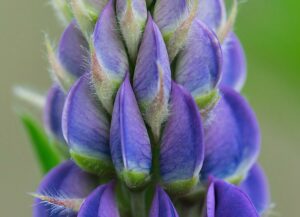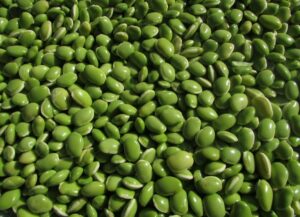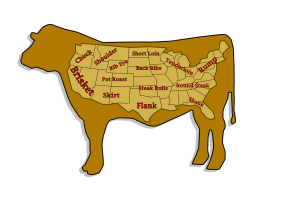Juan Sánchez Duarte & Fernando Díaz
Lupins (Lupinuss spp.) are legume seeds that can be an economic and nutritional source of protein for lactating dairy cows. Its high protein (35-40% dry matter; DM) and fat (9.8-11.5% DM) content, makes lupins a good alternative for replacing traditional protein meals in dairy farms.
Among the proteaginous that could replace soybean meal in dairy diets, lupins have the highest protein content. However, protein in lupins is highly degraded in the rumen. Thus, lupins protection treatment may be an effective solution to reduce rumen protein degradability. As can be seen in the table below, contents of fiber, fat, and non-fiber-carbohydrates are superior in lupin grain compared to those found in soybean meal.
| Parameter | Lupin | Soybean meal |
| Dry matter (DM) % | 90.2 | 89.2 |
| Crude protein (% DM) | 34.2 | 53.0 |
| NDF (% DM) | 23.9 | 11.4 |
| ADF (% DM) | 22.4 | 6.4 |
| Ether extract (% DM) | 9.4 | 1.2 |
| Starch (% DM) | 7.9 | 3.9 |
| NFC (% DM) | 29.8 | 25.4 |
Several studies demonstrated the effectiveness of replacing soybean meal with lupins. A study conducted at the University of Minnesota (May et al., 1993) determined the optimal substitution of soybean meal with lupins in early lactation diets. Diets were formulated to maintain a forage to concentrate ratio of 60:40, and include ground lupins at 25, 50, 75, and 100% on a DM basis. The findings indicated no differences on DM intake among diets; however, cows fed lupins at 75% yielded 2.8 kg/day more milk than cows receiving soybean meal. In addition, the researchers observed that milk production was greater when lupins were coarsely ground.
Later, in two separate experiments, researchers from Belgium (Froidmont et al., 2005) confirmed the effects of replacing 75% or 100% of soybean meal with coarsely ground lupins in lactating dairy cow diets. Dry matter intake and milk production were similar when lupins replaced 75% of soybean meal. In contrast, DM and crude protein intake were higher in cows when lupins replaced 100% of soybean meal in the diet. Thus, milk production was greater in cows fed lupins, and probably reflected the difference in DM and protein intake. However, milk fat concentration was depressed in cows receiving the lupin diets, which was associated to a modification of milk fatty acid profile as an effect of including oleic fatty acid when more lupins was incorporated into the diet.
Recently, a study from France (Mendowski et al., 2019) evaluated the effects of feeding soybean meal or lupin seeds either raw or extruded at 140 or 160°C to early lactating dairy cows. A small proportion of linseed (10%) was blended with lupin seeds during extrusion because linseed fat makes the passage of lupins easier by decreasing viscosity.
Extruding lupins at 160°C overprotected proteins and reduced amino acids availability in the small intestine. Dry matter intake was greater in cows fed soybean meal (21.3 kg/day) diets compared to the lupin diets (19.5 kg/day) but milk production was similar among diets (29.7 kg milk/day and 25.2 kg 4% fat-corrected-milk/day).
Although milk fat and protein concentrations were higher in cows fed the soybean meal diet, milk component yields were similar among diets (893 g fat/day and 882 g protein/day). Lower milk fat concentration observed in the lupin diets may be related to the fat supply from linseed, and to the fact that extrusion increases lipids availability in the rumen.
In conclusion, lupins are a good alternative protein supplement for lactating dairy cows. According to these studies, soybean meal can be replaced partially or totally in the diet with lupin seeds without affecting cow’s performance. However, including high levels of lupins in the diets may reduce milk fat concentration by modifying fatty acids profile in milk. Grinding lupin seeds coarsely is the best strategy to maximize milk production.
References
- Froidmont, N. Bartiaux-thill. 2005. Suitability of lupin and pea seeds as a substitute for soybean meal in high producing dairy cows. Animal Research. 53:475-487.
- G. May, D.E. Otterby, J.G. Linn, W.P. Hansen, D.G. Johnson, D.H. Putnam. 1993. Lupins (Lupinus albus) as a protein supplement for lactating Holstain dairy cows. Journal of Dairy Science. 76:2682-2691.
- Mendowski, P. Chapoutot, G. Chesneau, A. Ferlay, F. Enjalbert, G. Cantalapiedra-Hijar, A. Germain, P. Nozière. 2019. Effects of replacing soybean meal with raw or extruded blends containing faba bean and lupin seeds on nitrogen metabolism and performance of dairy cows. Journal of Dairy Science. 102:5130-5147.
© 2019 Dairy Knowledge Center, LLC. All Rights Reserved.









